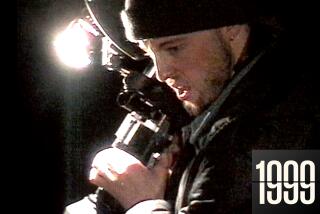Can an Island Hit Play in Peoria?
- Share via
How does a small, independently financed teen drama about racial conflict and friendship in a Hawaiian high school compete with big studio releases like “The Phantom Menace” and “The Matrix” when it doesn’t even have a distributor? So far, quite nicely.
In its initial release in six theaters on the Hawaiian Islands, the $1-million “Beyond Paradise” opened head-to-head with the second weekend of the hit film “The Matrix” and came out aces, actually beating it in a couple of theaters. This was despite the fact that it was self-released by a producers rep who put up a modest $10,000 advertising and marketing budget to support its entire run, and paid for the prints. Second weekend grosses also held strongly.
When “Beyond Paradise” headed east to Guam, it opened in second place behind “Star Wars: Episode I The Phantom Menace.”
In only eight theaters altogether, “Beyond Paradise” has grossed about $240,000 to date.
Despite that impressive performance, the film is having no luck finding a distributor on the mainland because it’s a drama without identifiable teen stars. “Beyond Paradise” is the first feature from 28-year-old documentarian David Cunningham, who grew up on the Big Island of Hawaii and experienced being in the minority as a white.
“I thought it would be interesting” to show things from that perspective, Cunningham says.
In addition to portraying racial tensions between native Hawaiians and haoles (as whites are referred to), “Beyond Paradise” also delves into other issues relevant to teenagers, including pregnancy, drugs and domestic abuse. Hawaii has one of the highest rates of teen pregnancy in the nation, according to Cunningham.
He raised the money through a consortium of 27 private investors and shot the film on the Kona Coast where he grew up. “It took a lot of work to raise the money,” Cunningham says. “Any time I went to an entertainment company, it was a waste of time. The range of investors we finally found included doctors, attorneys and finance corporations, all of whom invested because of the subject matter and its attempt to tap the youth market in a positive way.”
After sellout performances at the Hawaii International Film Festival and the AFI Fest in Los Angeles, “Beyond Paradise” came to the attention of California-based producers representative Jeff Dowd, who has handled some hard sells in the past such as “Hoosiers” and “Zebrahead.”
“I was impressed that a young person was trying to dramatize some of the realities people in high school have to deal with--racial differences, alienation and frustration--and how it often leads to violence unless those differences can be bridged,” Dowd says. “It was a positive movie done in an entertaining way. Reviewers have compared it to ‘Once Were Warriors’ and ‘American Graffiti.’ ”
After guiding Cunningham through some re-shoots and reediting, Dowd held sneak previews of the film in different parts of Southern California, including Marina del Rey and San Diego, which brought positive reactions from the recruited teen audiences. When he presented the results to distributors, however, he hit the traditional roadblock.
With no stars and serious subject matter, “Beyond Paradise” was nicely received, but perceived as too hard a sell to teens.
While the public and the media complain that many movies aimed at teenagers stress violence or irresponsible behavior, the economic reality is that teen dramas are even harder to market than serious adult-oriented movies.
The rare success of 1987’s “Stand and Deliver” required the concerted efforts of Warner Bros. and American Playhouse to get a toehold in the marketplace, according to Dowd.
“The resistance [from distributors] is legitimate,” Dowd says. “You have to take baby steps to make this kind of movie work. Specialized movies for teenagers are particularly challenging.”
But that’s not to say there isn’t an appetite for these movies, says Dowd. It’s just that getting the core audience’s attention is much more difficult. With movies aimed at the adult audience, the distributor can build word of mouth through positive critical response, Dowd explains, starting in major cities and eventually fanning out to the suburbs and smaller cities.
But that tactic hasn’t been tried for most youth-oriented movies, because teens are concentrated in the suburbs and they don’t generally read reviews or consult newspapers for their moviegoing decisions. They find out about movies mainly through television and radio, which requires a considerable financial investment.
To test the movie’s playability, Dowd approached Pacific Theaters’ buyer for Hawaii, Dean Schaff. “They screened the film for me, and though we don’t normally take on films without distributors, because of the cost of prints and advertising, I thought it was worth playing,” Schaff said.
Rather than take the traditional TV ad route, Cunningham and Dowd held several word-of-mouth screenings and relied heavily on radio promotions. “We even passed out fliers at local high schools,” Cunningham says. On its opening weekend, “Beyond Paradise” held its own against the blockbuster “Matrix,” and also performed “very respectably” against other films that were popular with teenagers, “Never Been Kissed” and “Twin Dragons,” Schaff says.
The Guam results were equally impressive--”Beyond Paradise” out-grossed “The Mummy” and “Entrapment,” according to the theater circuit that played it.
But it’s much more daunting to penetrate the U.S. mainland market without traditional television support, Schaff says.
Dowd concurs. Unlike the music business, where grunge bands can rise through the ranks by appearing in small clubs and on college radio stations, movies aimed at the teen market are basically all sold the same way--a national roll-out with an expensive media advertising blitz.
“The economics of today’s film world is that any movie for high school kids costs $6 million to $12 million to release nationally. We’re trying to find a middle ground, in between a big-city single theater release and a national roll-out.” The best way, he says, it to try out the film in single markets like San Diego or Seattle, and if it works, continue from there.
And if it doesn’t work after the initial test engagements?
“Then there are other outlets like home video, cable and network TV,” Dowd says. Even limited theatrical exposure would facilitate interest from these other areas. But the problem is wider than just “Beyond Paradise,” he says. The reason there are so few teen dramas is that any movie that aspires to be more than escapist entertainment faces the same challenge.
“If we try business as usual and go by the tried-and-true studio approach of hitting a home run every time,” Dowd says, “it’s not going to work. We have to roll the dice on alternative teenage movies and figure out an effective grass-roots marketing approach.”
In the interim, Wallace Theaters, which brought “Beyond Paradise” to Guam, owns screens across the South Pacific and will move the film from Guam to American Samoa, Dowd says.
With a deal also pending to bring the film to New Zealand, it would seem “Beyond Paradise” is challenging conventional marketing wisdom one island at a time.
More to Read
Only good movies
Get the Indie Focus newsletter, Mark Olsen's weekly guide to the world of cinema.
You may occasionally receive promotional content from the Los Angeles Times.










